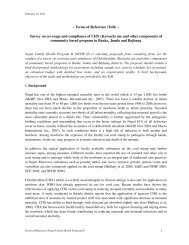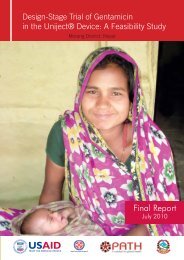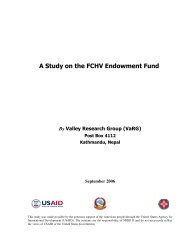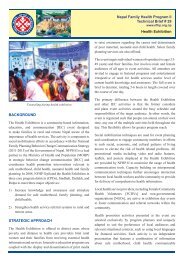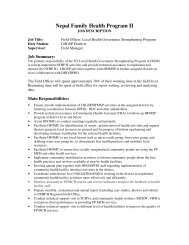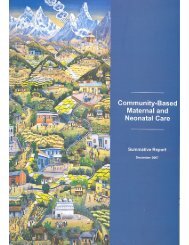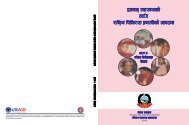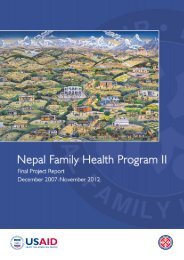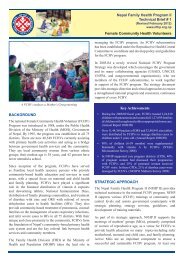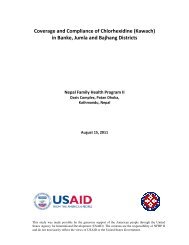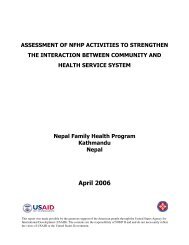(Kawach) in Banke, Jumla and Bajhang Districts - Nepal Family ...
(Kawach) in Banke, Jumla and Bajhang Districts - Nepal Family ...
(Kawach) in Banke, Jumla and Bajhang Districts - Nepal Family ...
Create successful ePaper yourself
Turn your PDF publications into a flip-book with our unique Google optimized e-Paper software.
1.0 Introduction<br />
1.1 Background<br />
Push<strong>in</strong>g for a better neonatal healthcare is crucial for the achievement of Millennium<br />
Development Goals (MDG) to reduce <strong>in</strong>fant <strong>and</strong> under-five mortality rate by two-thirds by<br />
2015. Data from the 2011 NDHS <strong>in</strong>dicate that there has been a slight decrease <strong>in</strong> under-five<br />
mortality rate that has gone down to 54 deaths per 1,000 live births from 118 deaths <strong>in</strong> 1996.<br />
Likewise, Infant Mortality Rate (IMR) has decl<strong>in</strong>ed from 79 per 1,000 live births to 48 for the<br />
same period. But, the further dissection of reduced under-five mortality <strong>and</strong> IMR reveal no<br />
significant progress <strong>in</strong> Neonatal Mortality Rate (NMR). Compared to other childhood<br />
mortality trend, the NMR has reduced to just 33 from 50 <strong>in</strong> the same 15 years period, which<br />
is more than double of the post-neonatal deaths at 13 per 1,000 live births (M<strong>in</strong>istry of Health<br />
<strong>and</strong> Population, New ERA, <strong>and</strong> Macro International Inc., 2011). Bear<strong>in</strong>g <strong>in</strong> m<strong>in</strong>d, 61 percent<br />
of deaths among children under five years <strong>and</strong> 72 percent of deaths among children under one<br />
year occur dur<strong>in</strong>g the first month of birth, it is requisite that the neonatal deaths should be<br />
prioritized <strong>in</strong> order to reduce the child <strong>and</strong> <strong>in</strong>fant mortality by two-thirds before 2015. Save<br />
the Children had po<strong>in</strong>ted that <strong>Nepal</strong>’s NMR is third highest <strong>in</strong> the world, (Save the<br />
Children/US, 2002) which entails lots of effort needed towards ensur<strong>in</strong>g neonatal health <strong>and</strong><br />
survival <strong>and</strong> further to address the apparent cause of neonatal mortality.<br />
NDHS 2006 illustrates that NMR <strong>in</strong> <strong>Nepal</strong> is highest <strong>in</strong> Mid-West (57 deaths/1,000 births)<br />
<strong>and</strong> Far-West (39 deaths/1,000 births) regions which also account for 86 percent <strong>and</strong> 90<br />
percent home deliveries respectively (M<strong>in</strong>istry of Health <strong>and</strong> Population, New ERA, <strong>and</strong><br />
Macro International Inc., 2006). The regions were observed with <strong>in</strong>stances of deliver<strong>in</strong>g a<br />
child <strong>in</strong> a cowshed (goth), especially by Dalits <strong>and</strong> also noted for unhygienic practices of<br />
h<strong>and</strong>l<strong>in</strong>g the newborn <strong>and</strong> umbilical cord (<strong>Nepal</strong> <strong>Family</strong> Health Program, New ERA, 2007).<br />
In addition, accord<strong>in</strong>g to NDHS 2006, use of non-sterile <strong>in</strong>struments to cut the umbilical<br />
cord; apply<strong>in</strong>g different non-medical substances on the cord stump <strong>and</strong> not wrapp<strong>in</strong>g the<br />
newborn with clean <strong>and</strong> warm cloth after the birth are common practices <strong>in</strong> these regions.<br />
Consequently an unhygienic place at the time of delivery, malpractices of h<strong>and</strong>l<strong>in</strong>g placenta<br />
<strong>and</strong> the cord stump, lack of awareness about risks associated with <strong>in</strong>fection, lack of<br />
knowledge of health service/providers <strong>and</strong>, adher<strong>in</strong>g to the traditional unhealthy practices,<br />
put the newborns to high risk of expos<strong>in</strong>g to pathogens. Such exposure to pathogens through<br />
h<strong>and</strong>s, clothes, <strong>in</strong>struments, <strong>and</strong> substances used on to cord stumps may result <strong>in</strong> an <strong>in</strong>fection<br />
of umbilical cord stump, known as omphalitis, that has been found contribut<strong>in</strong>g to neonatal<br />
morbidity <strong>and</strong> mortality <strong>in</strong> develop<strong>in</strong>g countries (Mullany et. al., 2006). Therefore, one<br />
crucial step to aide <strong>in</strong> reduc<strong>in</strong>g the NMR could be the prevention of omphalitis <strong>in</strong> neonates.<br />
A study conducted <strong>in</strong> Sarlahi <strong>in</strong> 2005 showed the risk of omphalitis markedly reduced by<br />
cleans<strong>in</strong>g the umbilical cord with Chlorhexid<strong>in</strong>e (CHX) compared to dry cord care or other<br />
home treatments. The report additionally claims that the early antisepsis of umbilical cord<br />
with CHX reduced the cord <strong>in</strong>fection <strong>and</strong> overall neonatal mortality. The mortality risk is<br />
lowered by 24 percent <strong>in</strong> the newborn receiv<strong>in</strong>g CHX cleans<strong>in</strong>g compared to neonates with<br />
dry cord care. Further, the risk is reduced by 34 percent if treated with CHX on the first day<br />
(24 hours) of their life (Mullany et. al., 2006).<br />
1



